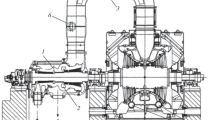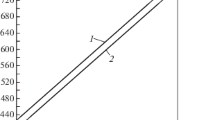Abstract
Technical viability and economic feasibility of improving the technology of a 450-MW CCGT unit’s participation in power load leveling of the power system operating in a GTU based CHP mode by transferring a 450-MW CCGT T-125/150 steam turbine to the driving mode instead of its shutdown are considered. It is shown that the shutdown of the steam turbine is associated with increased fuel consumption under start-up conditions, delayed steam turbine loading and the CCGT unit as a whole, and a loss of steam turbine life characteristics. The technology of transferring the 450-MW CCGT unit to the GTU based CHP mode, possible schemes of high- and low-pressure steam distributions between line water heaters, and methods and results of calculation of power parameters of the 450-MW CCGT unit with the turbine shutdown and transferring it to the driving mode in the absence and presence of peak-load heaters in the heat balance are presented. It is shown that switching the 450-MW CCGT unit from the base 290 MW electric load and 1006 GJ/h heat production to the GTU based CHP mode leads to a decrease in electric capacity of the CCGT unit by 90 MW and an increase in heat production by 335–348 GJ/h. Comparative graphs of the steam turbine start-up and the CCGT unit rated loading in the comparable variants after its operation in the GTU based CHP mode for 8–10 h are given. Evaluation techniques and results of the economic efficiency of the generator driving mode are compared with the shutdown of the steam turbine. Based on the performed calculations, it is shown that, for various combinations of fuel equivalent and electricity costs and heating tariffs, the expedient time for switching the steam turbine to the driving mode is 10–18 h. Additional advantages of the driving mode are noted, such as improvement of the steam turbine reliability due to the elimination of cyclic temperature variations of its steam-inlet elements and vibrational oscillations in the final stages of the low-pressure cylinder and the possibility of the steam turbine generator to operate as a synchronous condenser.
Similar content being viewed by others
References
E. K. Arakelyan, A. V. Andryushin, and K. A. Andryushin, “Increased reliability, manoeuvrability and durability of steam turbines through the implementation of the generator driving mode,” WIT Trans. Ecol. Environ. 205, 95–105 (2016).
E. K. Arakelyan, K. A. Andryushin, and I. Yu. Bezdelgin, “Study of the temperature state of the flow path of the T-125/150 steam turbine of PGU-450 at steam-free and driving modes,” Elektr. Stn., No. 6, 21–26 (2015).
V. V. Kulichikhin and V. F. Gutorov, The Use of the Driving Mode of Turbine Units at TPPs (SPO ORGRES, Moscow, 1977) [in Russian].
D. B. Kapelovich, L. N. Kobzarenko, and V. N. Baltyan, “Study of the schematic and the technology of the driving mode of K-160-130 turbine,” Elektr. Stn., No. 7, 26–30 (1987).
E. K. Arakelyan and V. A. Starshinov, Improving the Efficiency and Maneuverability of Thermal Power Plant Equipment (Mosk. Energ. Inst., Moscow, 1993) [in Russian].
A. A. Madoyan, B. L. Levchenko, and E. K. Arakelyan, Application of Driving Mode at Thermal Power Plants (Energiya, Moscow, 1980) [in Russian].
E. K. Arakelyan, A. V. Andryushin, S. Yu. Burtsev, and K. A. Andryushin, “Technical and economic feasibility of shifting the steam turbine of PGU-450 to driving mode,” Elektr. Stn., No. 6, 25–28 (2017).
A. D. Trukhnii, L. N. Kobzarenko, A. A. Madoyan, E. K. Arakelyan, A. A. Kochetov, and V. V. Pashchenko, “Low-cycle reliability of the rotors of the K-200-130 turbine at various ways of their withdrawal to the night reserve,” Teploenergetika, No. 10, 50–57 (1982).
V. A. Grachev, V. V. Kulichikhin, and B. N. Lyudomirskii, “Thermal condition of the T-100-130 turbine in driving mode,” Elektr. Stn., No. 9, 19–22 (1976).
G. A. Shapiro, Improving the Efficiency of Work of CHPPs (Energoizdat, Moscow, 1981) [in Russian].
V. V. Kulichikhin, “The effect of the modes of operation on oscillation of working blades of the last stage of a heating turbine,” Elektr. Stn., No. 7, 15–18 (1976).
V. A. Starshinov, L. V. Markaryan, E. K. Arakelyan, and A. L. Tserazov, “Energy characteristics of turbogenerators of TPPs in synchronous compensator mode,” Elektr. Stn., No. 2, 22–24 (1982).
Author information
Authors and Affiliations
Corresponding author
Additional information
Original Russian Text © E.K. Arakelyan, A.V. Andryushin, S.Yu. Burtsev, K.A. Andryushin, 2018, published in Teploenergetika.
Rights and permissions
About this article
Cite this article
Arakelyan, E.K., Andryushin, A.V., Burtsev, S.Y. et al. Investigation of Technical and Economic Viability of the 450-MW CCGT Unit’s Operation in the GTU Based CHP Mode. Therm. Eng. 65, 900–910 (2018). https://doi.org/10.1134/S0040601518120017
Received:
Accepted:
Published:
Issue Date:
DOI: https://doi.org/10.1134/S0040601518120017




